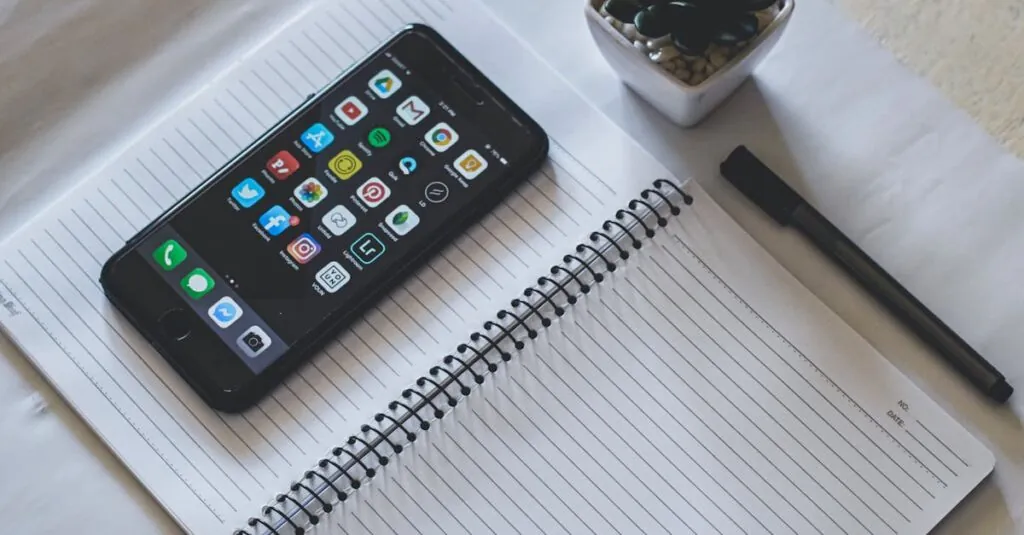Table of Contents
ToggleIn a world where apps multiply faster than rabbits, keeping your iPhone organized can feel like a full-time job. Those unused apps cluttering your screen? They’re like that one sock that always goes missing in the laundry—annoying and totally unnecessary. If you’ve ever found yourself scrolling through a sea of icons, wondering why you still have that old game or shopping app, it’s time to take action.
Understanding App Management on iPhone
Managing apps on an iPhone plays a crucial role in maintaining device performance and user experience. A well-organized app library can improve ease of use and functionality.
Importance of Deleting Unused Apps
Unused apps occupy valuable storage space and slow down device performance. Regularly removing these apps enhances speed and responsiveness. Many users find that they forget about apps once downloaded, leading to a cluttered interface. Deleting these items helps prevent accidental clicks and distractions when accessing the home screen. Additionally, it’s important to consider the implications of privacy. Outdated apps may not receive updates and could pose security risks. By managing the app selection, users ensure a safer and more efficient experience on their iPhones.
Benefits of Keeping Your Home Screen Organized
A clean home screen enhances accessibility and efficiency when navigating applications. Organized layouts save time by enabling quick access to frequently used apps. Users benefit from grouping similar applications together, which simplifies task management. An aesthetically pleasing home screen also contributes to a more enjoyable overall experience. By maintaining an organized interface, users improve focus, reducing the temptation to engage with irrelevant apps. Structured home screens promote a sense of control over device use, leading to better productivity and satisfaction.
Methods to Delete Apps from iPhone
Managing apps on an iPhone simplifies device usage and improves performance. Consider the following methods for deleting unwanted apps.
Deleting Apps via the Home Screen
Users can easily delete apps directly from the home screen. Press and hold the app icon until a menu appears. Select “Remove App” from the options. Afterwards, choose “Delete App,” and confirm the action to remove it. This method provides quick access to app management without navigating through settings.
Using the App Library to Delete Apps
The App Library offers another efficient way to delete apps. Swipe left past the last home screen to access the App Library. Locate the app by browsing or using the search bar. Press and hold the app icon, then select “Delete App” from the context menu. Confirm the deletion to permanently remove the app.
Removing Apps in Settings
Users can also delete apps through the Settings menu. Open the Settings app and navigate to “General,” then tap “iPhone Storage.” Scroll through the list of installed apps and select the app to delete. Tap “Delete App,” and confirm to finalize the process. This method provides an overview of storage usage, assisting users in managing apps effectively.
Tips for Managing App Storage
Managing app storage effectively enhances the iPhone experience. By staying aware of storage usage, users can maintain device performance and efficiency.
Monitoring Storage Usage
Monitoring storage usage is essential for optimal iPhone performance. Users can check storage by navigating to “Settings,” then selecting “General” and “iPhone Storage.” This overview displays how much space each app occupies, making it simple to identify heavy applications. They can sort apps by storage size, ensuring priority is given to large file apps for deletion consideration. Regularly reviewing this data prevents unexpected storage shortages and alleviates performance slowdowns caused by overloaded memory.
Recommendations for App Management
Recommendations for app management can simplify the iPhone experience. Regularly deleting unused apps significantly frees up storage space. Users can also consider offloading unused apps, which retains data but removes the app itself. Prioritizing essential apps and keeping frequently used applications readily accessible on the home screen boosts efficiency. Additionally, utilizing folders for organizing similar apps aids in keeping the home screen tidy. Setting reminders to review apps monthly prevents clutter from accumulating and ensures the device remains functional and streamlined.
Managing apps on an iPhone is essential for enhancing performance and user experience. By regularly deleting unused apps users can free up valuable storage space and maintain a streamlined device. The various methods for app deletion empower users to take control of their app library.
An organized home screen not only improves accessibility but also reduces distractions. Regularly reviewing app usage and setting reminders can help keep the device clutter-free. With these practices in place users can enjoy a more efficient and enjoyable iPhone experience.




